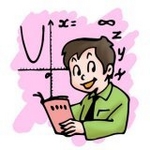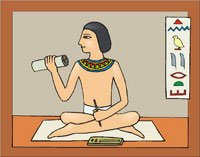
Worksheets and No Prep Teaching Resources
Reading Comprehension Worksheets
History of Mathematics

History of Mathematics
 Worksheets and No Prep Teaching Resources Reading Comprehension Worksheets History of Mathematics |
 History of Mathematics |
| edHelper's suggested reading level: | grades 9 to 12 | |
| Flesch-Kincaid grade level: | 10.41 |
|
Ahmes and Angles - Egyptian Mathematics
By Colleen Messina |

|
 1 In the 1850s, a man named Mr. Rhind bought an amazing papyrus manuscript. A scribe named Ahmes, the Moonborn, wrote the manuscript in 1575 B.C., and it contains most of what we now know about Egyptian mathematics. The manuscript describes the Egyptian number system, the Egyptian use of fractions to divide rations of bread and beer among the workers, and geometric calculations. The Rhind Papyrus hangs in the British Museum in London, and it is one of the oldest mathematical documents in the world. Although it is hard to pinpoint exact dates for ancient cultures, the Egyptians' civilization thrived from about 4000 B.C. to 500 B.C., and they made many strides in the development of mathematics.
1 In the 1850s, a man named Mr. Rhind bought an amazing papyrus manuscript. A scribe named Ahmes, the Moonborn, wrote the manuscript in 1575 B.C., and it contains most of what we now know about Egyptian mathematics. The manuscript describes the Egyptian number system, the Egyptian use of fractions to divide rations of bread and beer among the workers, and geometric calculations. The Rhind Papyrus hangs in the British Museum in London, and it is one of the oldest mathematical documents in the world. Although it is hard to pinpoint exact dates for ancient cultures, the Egyptians' civilization thrived from about 4000 B.C. to 500 B.C., and they made many strides in the development of mathematics. |
Create Weekly Reading Books
Prepare for an entire week at once! |
| Leave your feedback on Ahmes and Angles - Egyptian Mathematics (use this link if you found an error in the story) |
 |
History of Mathematics
|
 |
High School Reading Comprehensions and High School Reading Lessons
|
 |
Social Studies
|